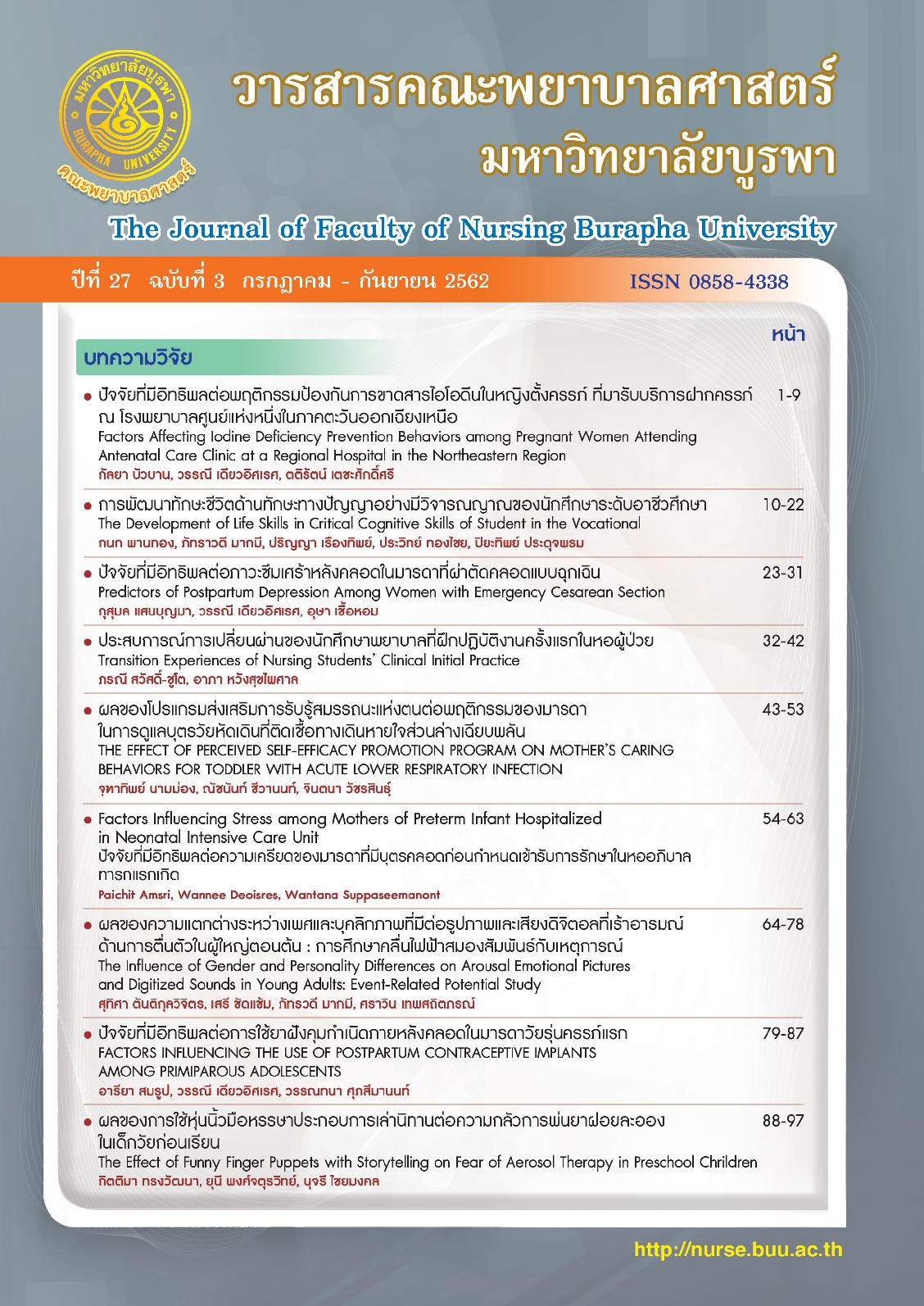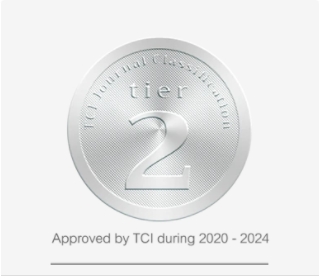ปัจจัยที่มีอิทธิพลต่อการใช้ยาฝังคุมกำเนิดภายหลังคลอดในมารดาวัยรุ่นครรภ์แรก
คำสำคัญ:
ความรู้, ทัศนคติ, อิทธิพลของบุคคลสำคัญ, ยาฝังคุมกำเนิด, มารดาวัยรุ่นครรภ์แรกบทคัดย่อ
บทคัดย่อ
การวิจัยแบบมีกลุ่มควบคุมครั้งนี้เพื่อศึกษาอิทธิพลของความรู้เกี่ยวกับยาฝังคุมกำเนิด ทัศนคติต่อยาฝังคุมกำเนิด การวางแผนมีบุตร และอิทธิพลของบุคคลสำคัญต่อการใช้ยาฝังคุมกำเนิดภายหลังคลอดในมารดาวัยรุ่นครรภ์แรก กลุ่มตัวอย่างคือ มารดาวัยรุ่นหลังคลอดครรภ์แรกที่พักฟื้นแผนกหลังคลอดหรือมารับบริการแผนกวางแผนครอบครัว ณ โรงพยาบาลสมเด็จพระบรมราชเทวี ณ ศรีราชา และโรงพยาบาลบางละมุง จำนวน 134 ราย คัดเลือกกลุ่มตัวอย่างที่มีคุณสมบัติตามเกณฑ์ เครื่องมือที่ใช้เก็บรวบรวมข้อมูล ได้แก่ แบบบันทึกข้อมูลส่วนบุคคลและการใช้ยาฝังคุมกำเนิดหลังคลอด แบบสอบถามความรู้เกี่ยวกับยาฝังคุมกำเนิด แบบสอบถามทัศนคติต่อยาฝังคุมกำเนิด และแบบสอบถามอิทธิพลของบุคคลสำคัญต่อการใช้ยาฝังคุมกำเนิด ค่าความเชื่อมั่นของแบบสอบถามเท่ากับ .73, .83, .91 ตามลำดับ วิเคราะห์ข้อมูลโดยสถิติพรรณนาและการวิเคราะห์ถดถอยโลจิสติก
ผลการวิจัยพบว่าปัจจัยที่มีอิทธิพลต่อการใช้ยาฝังคุมกำเนิดภายหลังคลอดอย่างมีนัยสำคัญทางสถิติ ได้แก่ อิทธิพลของบุคคลสำคัญ (AOR = 1.11, 95% CI = 1.05-1.17) โดยกลุ่มตัวอย่างที่บุคคลสำคัญสนับสนุนให้ใช้ยาฝังคุมกำเนิดมากจะมีการใช้ยาฝังคุมกำเนิดเป็น 1.11 เท่าของกลุ่มตัวอย่างที่บุคคลสำคัญสนับสนุนให้ใช้ยาฝังคุมกำเนิดน้อย ผลการศึกษามีข้อเสนอแนะว่า พยาบาลผดุงครรภ์และบุคลากรด้านสุขภาพในหน่วยงานแผนกหลังคลอดและวางแผนครอบครัว ควรส่งเสริมให้บุคคลที่มีความสำคัญต่อมารดาวัยรุ่นมีส่วนร่วมในการให้คำแนะนำปรึกษาแก่มารดาวัยรุ่น เพื่อให้มารดาวัยรุ่นมีการใช้ยาฝังคุมกำเนิดหลังคลอดและป้องกันการตั้งครรภ์ซ้ำที่อาจเกิดขึ้นได้
References
and young adult women's knowledge of and attitudes toward etonogestrel implants. Journal of Pediatric and Adolescent Gynecology, 28(4), 229-233.
Birhane, K., Tsegaye, W., Mulaw, A., Nemomsa, C., Abebe, G., Derese, G., Asswfa, K., &
Negash, W. (2016). Utilization of long acting reversible contraceptive methods and associated factors among female college students in Debre Berhan town, Ethiopia. Advances In Applied Sciences, 1(1), 18-23.
Bureau of Reproductive Health Department of Health. (2017). Thailand reproductive health
database. Retrieved from http://rhdata.anamai.moph.go.th/index.php/family planning/familyplanning17 [In Thai]
Chandra-Mouli, V., McCarraher, D. R., Phillips, S. J., Williamson, N. E., & Hainsworth, G. (2014).
Contraception for adolescents in low and middle income countries: needs, barriers, and access. Reproductive Health, 11(1), 1-8.
Choonil, R., Saejeng, K., Sukarat, B. (2015). Contraceptive service provision of hospitals in Thailand in 2015. Bangkok: Bureau of Reproductive Health Department of Health. [In Thai]
Hubacher, D., Olawo, A., Manduku, C., & Kiarie, J. (2011). Factors associated with uptake
subdermal contraceptive implants in a young Kenyan population. Contraception, 84(4), 413-417.
Jumklang, S., Srisuriyawet, R., & Homsin, P. (2017). Correlated factors with decision making of
birth control implant used based on the information-motivation behavioral skills model (IMB model) among teen mothers. The Journal of Faculty of Nursing Burapha University, 25(2), 31-42. [In Thai]
Khashan, A. S., Baker, P. N., & Kenny, L. C. (2010). Preterm birth and reduced birth weight in
first and second teenage pregnancies: A register-based cohort study, BioMed Central Pregnancy and Childbirth, 10(36), 1-8.
Narydsangkharn, S. (2018). Effects of a promoting the use of contraceptive implant program
on knowledge, readiness and immediate postpartum contraceptive implant use among teenage mothers. Master of Nursing Science Thesis, Midwifery, Faculty of Nursing, Burapha University. [In Thai]
Peduzzi, P., Concato, J., Kemper, E., Holford, T.R., & Feinstein, A.R. (1996). A simulation study
of the number of events per variable in logistic regression analysis. Journal of Clinical Epidemiology, 49(12), 1373-1379.
Pungbangkadee, R., & Ratinthorn, A. (2014). Factors and consequences of repeat pregnancy
among teenagers: A case study in Bangkok metropolis. Journal of Nursing Science, 32(2), 23-31. [In Thai]
Schwartz, N. E. (1975). Nutritional knowledge, attitude and practice of high school graduated.
Journal of The American Dietetic Association, 66(1), 25-31.
Wattanathamrong, V., Sirisopon, N., Kainakha, P., Onsiri, S., Amitpie, C., Anek, A., Napatpittayatorn, P., & Polsron, K. (2017). Factors related intention contraception
type implants in repeat pregnancies adolescents. Journal of The Royal Thai Army Nurses, 18(Supplement), 102-111. [In Thai]
Wattanathamrong, V. (2015). Factors related intention semi-permanent contraception
type implants in repeat pregnancies adolescents. Master Thesis, Health Education, Graduate school, Kasetsart University. [In Thai]
World Health Organization [WHO]. (2014). Adolescent pregnancy. Retrieved from
http://www.who.int/mediacentre/factsheets/fs364/en/
The American College of Obstetricians and Gynecologists. (2017). Long-acting reversible
contraception: Implants and intrauterine devices. Obstetrics and Gynecology, 130(5), 251-269.





